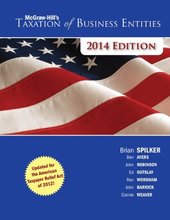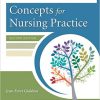McGraw-Hill’s Taxation of Business Entities, 2014 Edition Spilker 5th Edition Test Bank
$35.00 Original price was: $35.00.$26.50Current price is: $26.50.
McGraw-Hill’s Taxation of Business Entities, 2014 Edition Spilker 5th Edition Test Bank
Instant download McGraw-Hill’s Taxation of Business Entities, 2014 Edition Spilker 5th Edition Test Bank pdf docx epub after payment.

Product details:
- ISBN-10 : 007763179X
- ISBN-13 : 978-0077631796
- Author: Brian Spilker (Author), Benjamin Ayers (Author), John Robinson (Author), Edmund Outslay (Author)
McGraw-Hill’s Taxation Series continues to provide a unique, innovative, and engaging learning experience for students studying taxation. The breadth of the topical coverage, the storyline approach to presenting the material, the emphasis on the tax and nontax consequences of multiple parties involved in transactions, and the integration of financial and tax accounting topics make this book ideal for the modern tax curriculum.
With over 275 schools adopting the 4th edition, McGraw-Hill’s Taxation of Individuals and Business Entities resonates with instructors who were in need of a bold and innovative approach to teaching tax. 350 professors have contributed 370 book reviews, in addition to 20 focus groups and symposia. These instructors were impressed on the book’s organization, pedagogy, and unique features that are a testament to the grassroots nature of this book’s development.
Table of contents:
- Chapter 1: An Introduction to Tax
- Chapter 1 Introduction
- Who Cares About Taxes and Why?
- What Qualifies as a Tax?
- How to Calculate a Tax
- Different Ways to Measure Tax Rates
- Tax Rate Structures
- Proportional Tax Rate Structure
- Progressive Tax Rate Structure
- Regressive Tax Rate Structure
- Types of Taxes
- Federal Taxes
- State and Local Taxes
- Implicit Taxes
- Evaluating Alternative Tax Systems
- Sufficiency
- Equity
- Certainty
- Convenience
- Economy
- Evaluating Tax Systems—The Trade-Offs
- Conclusion
- Chapter 1: Summary
- Chapter 1: Key Terms
- Chapter 1: Discussion Questions
- Chapter 1: Problems
- Chapter 2: Tax Compliance, the IRS, and Tax Authorities
- Chapter 2 Introduction
- Taxpayer Filing Requirements
- Tax Return Due Date and Extensions
- Statute of Limitations
- IRS Audit Selection
- Types of Audits
- Tax Law Sources
- Legislative Sources: Congress and the Constitution
- Judicial Sources: The Courts
- Administrative Sources: The U.S. Treasury
- Tax Research
- Step 1: Understand Facts
- Step 2: Identify Issues
- Step 3: Locate Relevant Authorities
- Step 4: Analyze Tax Authorities
- Step 5: Document and Communicate the Results
- Tax Professional Responsibilities
- Taxpayer and Tax Return Preparer Penalties
- Conclusion
- Chapter 2: Summary
- Chapter 2: Key Terms
- Chapter 2: Discussion Questions
- Chapter 2: Problems
- Chapter 3: Tax Planning Strategies and Related Limitations
- Chapter 3 Introduction
- Basic Tax Planning Overview
- Timing Strategies
- Present Value of Money
- The Timing Strategy When Tax Rates Are Constant
- The Timing Strategy When Tax Rates Change
- Income-Shifting Strategies
- Transactions between Family Members and Limitations
- Transactions between Owners and Their Businesses and Limitations
- Income Shifting across Jurisdictions and Limitations
- Conversion Strategies
- Limitations of Conversion Strategies
- Additional Limitations to Tax Planning Strategies: Judicially Based Doctrines
- Tax Avoidance versus Tax Evasion
- Conclusion
- Chapter 3: Summary
- Chapter 3: Key Terms
- Chapter 3: Discussion Questions
- Chapter 3: Problems
- Chapter 4: Individual Income Tax Overview, Dependents, and Filing Status
- Chapter 4 Introduction
- The Individual Income Tax Formula
- Gross Income
- Character of Income
- Deductions
- Income Tax Calculation
- Other Taxes
- Tax Credits
- Tax Prepayments
- Dependents of the Taxpayer
- Dependency Requirements
- Filing Status
- Married Filing Jointly and Married Filing Separately
- Qualifying Widow or Widower (Surviving Spouse)
- Single
- Head of Household
- Summary of Income Tax Formula
- Conclusion
- Appendix A: Dependency Exemption Flowchart (Part I)
- Appendix B: Qualifying Person for Head of Household Filing Status Flowchart
- Appendix C: Determination of Filing Status Flowchart
- Chapter 4: Summary
- Chapter 4: Key Terms
- Chapter 4: Discussion Questions
- Chapter 4: Problems
- Chapter 4: Comprehensive Problems
- Chapter 5: Gross Income and Exclusions
- Chapter 5 Introduction
- Realization and Recognition of Income
- What Is Included in Gross Income?
- Other Income Concepts
- When Do Taxpayers Recognize Income?
- Who Recognizes the Income?
- Types of Income
- Income from Services
- Income from Property
- Other Sources of Gross Income
- Exclusion Provisions
- Common Exclusions
- Education-Related Exclusions
- Exclusions That Mitigate Double Taxation
- Sickness and Injury-Related Exclusions
- Deferral Provisions
- Income Summary
- Conclusion
- Appendix: 2021 Social Security Worksheet from Form 1040 Instructions
- Chapter 5: Summary
- Chapter 5: Key Terms
- Chapter 5: Discussion Questions
- Chapter 5: Problems
- Chapter 5: Comprehensive Problems
- Chapter 6: Individual Deductions
- Chapter 6 Introduction
- Deductions for AGI
- Deductions Directly Related to Business Activities
- Deductions Indirectly Related to Business Activities
- Deductions Subsidizing Specific Activities
- Summary: Deductions for AGI
- Deductions from AGI: Itemized Deductions
- Medical Expenses
- Taxes
- Interest
- Charitable Contributions
- Special 2021 From AGI Charitable Contribution Deduction for Taxpayers Not Itemizing Deductions
- Casualty and Theft Losses on Personal-Use Assets
- Other Itemized Deductions
- Summary of Itemized Deductions
- The Standard Deduction
- Standard Deduction
- Deduction for Qualified Business Income
- Deduction for Qualified Business Income
- Limitations
- Taxable Income Summary
- Conclusion
- Chapter 6: Summary
- Chapter 6: Key Terms
- Chapter 6: Discussion Questions
- Chapter 6: Problems
- Chapter 6: Comprehensive Problems
- Chapter 7: Investments
- Chapter 7 Introduction
- Investments Overview
- Portfolio Income: Interest and Dividends
- Interest
- Dividends
- Portfolio Income: Capital Gains and Losses
- Types of Capital Gains and Losses
- Limits for Capital Loss Deductions
- Balancing Tax Planning Strategies for Capital Assets with Other Goals
- Portfolio Income Summary
- Investment Interest Expense and Net Investment Income Tax
- Net Investment Income Tax
- Passive Activity Income and Losses
- Passive Activity Definition
- Income and Loss Categories
- Rental Real Estate Exception to the Passive Activity Loss Rules
- Net Investment Income Tax on Net Passive Income
- Conclusion
- Appendix A: detailed step-by-step guide to the capital gains netting process
- Chapter 7: Summary
- Chapter 7: Key Terms
- Chapter 7: Discussion Questions
- Chapter 7: Problems
- Chapter 7: Comprehensive Problem
- Chapter 8: Individual Income Tax Computation and Tax Credits
- Chapter 8 Introduction
- Regular Federal Income Tax Computation
- Tax Rate Schedules
- Marriage Penalty or Benefit
- Exceptions to the Basic Tax Computation
- Alternative Minimum Tax
- Alternative Minimum Tax Formula
- Additional Taxes
- Employment and Self-Employment Taxes
- Tax Credits
- Nonrefundable Personal Credits
- Refundable Personal Credits
- Business Tax Credits
- Tax Credit Summary
- Credit Application Sequence
- Taxpayer Prepayments and Filing Requirements
- Prepayments
- Filing Requirements
- Tax Summary
- Conclusion
- Chapter 8: Summary
- Chapter 8: Key Terms
- Chapter 8: Discussion Questions
- Chapter 8: Problems
- Chapter 8: Comprehensive Problems
- Chapter 9: Business Income, Deductions, and Accounting Methods
- Chapter 9 Introduction
- Business Gross Income
- Gross Receipts Test for Determining Small Businesses
- Business Deductions
- Ordinary and Necessary
- Reasonable in Amount
- Limitations on Business Deductions
- Expenditures against Public Policy
- Political Contributions and Lobbying Costs
- Capital Expenditures
- Expenses Associated with the Production of Tax-Exempt Income
- Personal Expenditures
- Mixed-Motive Expenditures
- Limitation on Business Interest Deductions
- Losses on Dispositions of Business Property
- Business Casualty Losses
- Accounting Periods
- Accounting Methods
- Financial and Tax Accounting Methods
- Overall Accounting Method
- Accrual Income
- Taxation of Advance Payments of Income (Unearned Income)
- Inventories
- Accrual Deductions
- Comparison of Accrual and Cash Methods
- Adopting an Accounting Method
- Changing Accounting Methods
- Conclusion
- Chapter 9: Summary
- Chapter 9: Key Terms
- Chapter 9: Discussion Questions
- Chapter 9: Problems
- Chapter 9: Comprehensive Problems
- Chapter 10: Property Acquisition and Cost Recovery
- Chapter 10 Introduction
- Cost Recovery and Tax Basis for Cost Recovery
- Basis for Cost Recovery
- Depreciation
- Personal Property Depreciation
- Real Property
- Special Rules Relating to Cost Recovery
- Depreciation for the Alternative Minimum Tax
- Depreciation Summary
- Amortization
- Section 197 Intangibles
- Organizational Expenditures and Start-Up Costs
- Research and Experimentation Expenditures
- Patents and Copyrights
- Amortizable Intangible Asset Summary
- Depletion
- Conclusion
- Appendix A: MACRS Tables
- Chapter 10: Summary
- Chapter 10: Key Terms
- Chapter 10: Discussion Questions
- Chapter 10: Problems
- Chapter 10: Comprehensive Problems
People also search:
McGraw-Hill’s Taxation of Business Entities, 2014 Edition
McGraw-Hill’s Taxation of Business Entities, 2014 Edition Spilker Ayers Robinson
McGraw-Hill’s Taxation of Business Entities, 2014 Edition Spilker Ayers Robinson 5th
McGraw-Hill’s Taxation of Business Entities, 2014 Edition Spilker Ayers Robinson 5th Test Bank
McGraw-Hill’s Taxation of Business Entities, 2014 Edition Spilker 5th Edition Test Bank
Related products
Test Bank
Test Bank for Operating Systems: Internals and Design Principles, 7th Edition: William Stallings
Test Bank
Test Bank for Decision Support and Business Intelligence Systems, 9th Edition: Efraim Turban











